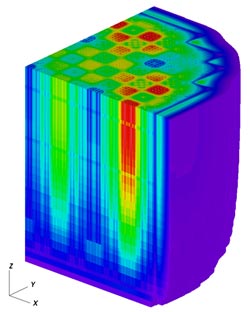CASL milestone validates reactor model using TVA data

This CASL visualization shows the thermal distribution of neutrons in Watts Bar Unit 1 Cycle 1 reactor core at initial criticality, as calculated by the VERA program. Image courtesy of Oak Ridge National Laboratory<br>
CASL is modeling nuclear reactors on supercomputers to help researchers better understand reactor performance with much higher reliability than previously available methods, with the goal of ultimately increasing power output, extending reactor life, and reducing waste.
Simulation results from the Virtual Environment for Reactor Applications (VERA) program, developed by CASL, were compared with actual data provided by the Tennessee Valley Authority's (TVA) Watts Bar Nuclear Plant in Tennessee, which confirmed its accuracy.
“VERA's capabilities range from simulating single fuel pins to modeling an entire operational reactor core,” said Jess Gehin of Oak Ridge National Laboratory's Reactor and Nuclear Systems Division. “It addresses operational challenges and supports increased power generation by exploring greater efficiency and life extensions.”
During cycle startup of commercial nuclear power reactors, technicians perform a series of tests to confirm the reactor is operating as expected. For CASL, results of previous tests are useful for demonstrating the accuracy of the VERA software. As a CASL partner, TVA provided detailed historical information and measured operational data from the Watts Bar plant to allow comparisons of the VERA simulation.
The simulations of the reactor startup tests are just a first step in the demonstration of VERA. CASL is extending the program's capability to simulate full power operation of the TVA reactor, which will require further VERA development to integrate the nuclear and thermal hydraulic physics. These additional capabilities will allow researchers to pursue breakthroughs in understanding key phenomena in the operating reactors.
CASL, headquartered at ORNL, is one of the Department of Energy's Energy Innovation Hubs. First established in 2010, CASL brings together industry, academia, and national labs to provide advanced modeling and simulation solutions for commercial reactors. Its mission is to confidently predict the performance of nuclear reactors through comprehensive science-based modeling and simulation technology that is deployed and applied broadly throughout the nuclear energy industry to enhance safety, reliability and economics.
The Hub's 10 core partners include: the Electric Power Research Institute, Idaho National Laboratory, Los Alamos National Laboratory, Massachusetts Institute of Technology, North Carolina State University, Sandia National Laboratories, Tennessee Valley Authority, University of Michigan, Westinghouse Electric Company and Oak Ridge National Laboratory. More information about CASL is available at http://www.casl.gov.
Media Contact
More Information:
http://www.ornl.govAll latest news from the category: Physics and Astronomy
This area deals with the fundamental laws and building blocks of nature and how they interact, the properties and the behavior of matter, and research into space and time and their structures.
innovations-report provides in-depth reports and articles on subjects such as astrophysics, laser technologies, nuclear, quantum, particle and solid-state physics, nanotechnologies, planetary research and findings (Mars, Venus) and developments related to the Hubble Telescope.
Newest articles

Superradiant atoms could push the boundaries of how precisely time can be measured
Superradiant atoms can help us measure time more precisely than ever. In a new study, researchers from the University of Copenhagen present a new method for measuring the time interval,…

Ion thermoelectric conversion devices for near room temperature
The electrode sheet of the thermoelectric device consists of ionic hydrogel, which is sandwiched between the electrodes to form, and the Prussian blue on the electrode undergoes a redox reaction…

Zap Energy achieves 37-million-degree temperatures in a compact device
New publication reports record electron temperatures for a small-scale, sheared-flow-stabilized Z-pinch fusion device. In the nine decades since humans first produced fusion reactions, only a few fusion technologies have demonstrated…





















